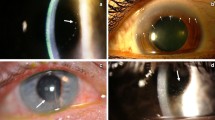Abstract
•Background: Longlasting inflammation is a major problem in treatment after severe eye burns and may find expression in an altered elemental composition of the conjunctiva. Particulate contamination of biological tissue induces such inflammatory processes. In the anterior eye segment, trauma or subsequent therapy may give rise to such contamination. Scanning electron microscopy and energy-dispersive X-ray analysis are able to detect traumatic residues of submicron size and changes of the elemental composition.
•Methods: Conjunctival specimens from first-time peridectomy of three healthy and nine severely burnt-eyes were examined with scanning electron microscopy and energy-dispersive X-ray analysis. The samples were prepared as cryo- or paraffin sections, mounted on carbon blocks and coated with evaporated elemental carbon.
•Results: The samples of healthy conjunctiva showed higher concentrations of Na, P and CI. These elements showed lower concentrations in conjunctival stroma of burnt eyes excised before the 20th day after trauma than in material obtained subsequently. In two burnt conjunctival specimens there was severe traumatic contamination with Ca in Ca(OH)2 and CaO burns, and in one case the traumatic substance was Si, in a peroxide plus silicone spray burn. In the remaining six cases, particulate contamination with Fe, Al, Ni, Zn, Cu, Ti and other substances was present in the burnt conjunctivas, while no contamination was detected in the specimens of healthy conjunctivas.
•Conclusions: The origin of the contaminant particles is assumed to be the trauma itself and the subsequent therapy. These investigations stress the importance, for clinical purposes, or early peridectomy and contamination-free therapy.
Similar content being viewed by others
References
Abraham JL, Burnett BR (1983) Quantitative analysis of inorganic particulate burden in situ in tissue sections. Scanning Electron Microsc (II) 681–696
Baker D, Kupke KG, Ingram P, Roggli VL, Shelburne JD (1985) Microprobe analysis in human pathology. Scanning Electron Microsc (II) 659–680
Bonafonte S, Fernandez del Cotero JN, Aguirre Villa-Coro A (1988) Mineral analysis in experimental corneal scars: an EDAX study. Cornea 7:122–126
Denig R (1912) Chirurgische Behandlung für Kalkverletzungen des Auges. Münch Med Wochenschr 61:579–580
Hall TA (1979) Biological X-ray microanalysis. J Microsc 117:145–163
Hollwich F, Huismans H (1968) Zur Passowschen Frühoperation bei Kalkverätzungen. Klin Monatsbl Augenheilk 154:233–238
Isaacson M, Kopf D, Ohtsuki M, Utlaut M (1979) Contamination as a psychological problem. Ultramicroscopy 4:97–99
Karcioglu ZA, Aran AJ, Holmes DL, Karcioglu Z (1988) Inflammation due to surgical glove powders in rabbit eyes. Arch Ophthalmol 106:808–811
Neuman J (1935) Frühzeitige operative Behandlung der Augenverätzung, sowie ihre experimentellen und pathologisch-anatomischen Grundlagen. Klin Monatsbl Augenheilkd 95:491–515
Passow A (1939) Denigsche Plastik und vereinfachtes Operationsverfahren bei Kalkverätzungen. Klin Monatsbl Augenheilkd 102:431
Passow A (1955) Ambulant durchführbare Frühoperation bei Verätzungen des Auges zur Behandlung. Klin Monatsbl Augenheilkd 127:129:142
Reim M, Teping C (1989) Surgical procedures in the treatment of most severe eye burns. Acta Ophthalmol [Suppl] 67:47–54
Roomans GM (1980) Problems in quantitative X-ray microanalysis of biological specimens. Scanning Electron Microsc (II) 309:320
Schrage NF, Reim M, Burchard WG (1988) Untersuchungen an schwerstverätzten Corneae nach Langzeittherapie, unter besonderer Beachtung von partikulären Rückständen aus Trauma und Therapeutika.Beitr Elektronenmikroskop Direktabb Oberfl 21:465–472
Thiel R (1965) Behandlung von Verätzungen. Klin Monatsbl Augenheilkd 146:581–586
Winding O, Gregersen E (1985) Particulate contamination in eye surgery. Acta Ophthalmol 63:629–633
Author information
Authors and Affiliations
Rights and permissions
About this article
Cite this article
Schirner, G., Schrage, N.F., Salla, S. et al. Conjunctival tissue examination in severe eye burns: a study with scanning electron microscopy and energy-dispersive X-ray analysis. Graefe's Arch Clin Exp Ophthalmol 233, 251–256 (1995). https://doi.org/10.1007/BF00177645
Received:
Revised:
Accepted:
Issue Date:
DOI: https://doi.org/10.1007/BF00177645




